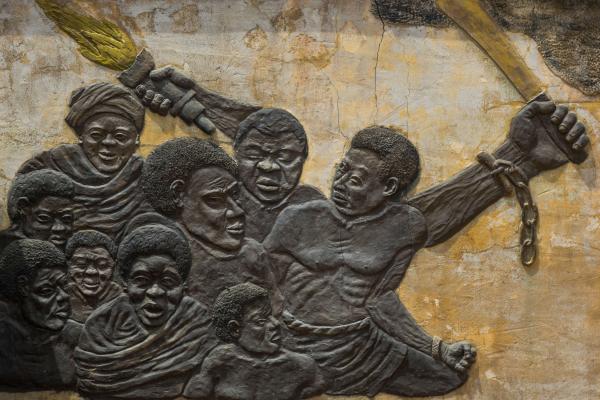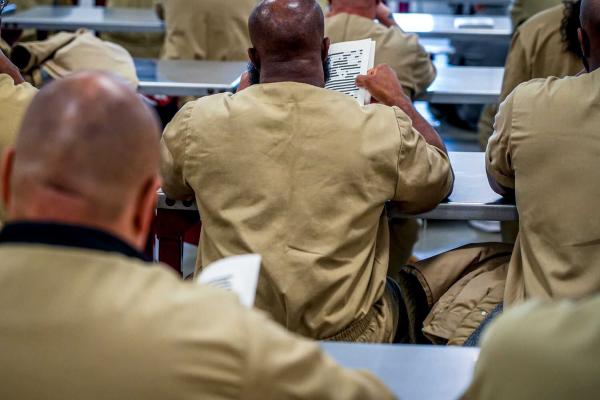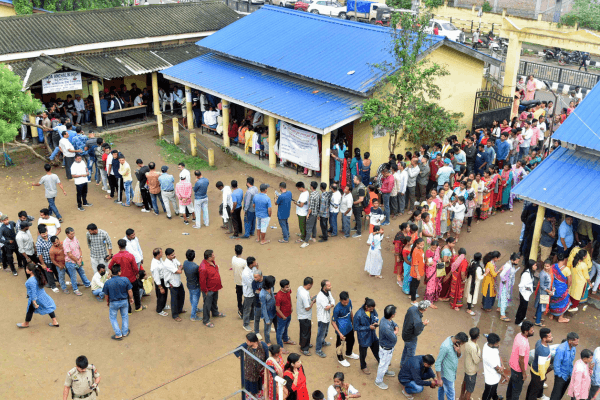Less than a week into the new year, the country watched in shock as hundreds of rioters used metal pipes and tear gas against police to gain entry into the U.S. Capitol, ransacking congressional offices for several hours while the nation’s elected leaders, who had convened to certify electoral votes, huddled for cover.
But faith-based communities and other justice advocates saw something like this coming.
“It wasn't a mystery that violence could happen because it happened before,” Rev. Graylan Scott Hagler, senior minister of Plymouth Congressional United Church of Christ and chairperson of Faith Strategies, a D.C.-based network of faith leaders who work to promote social justice, told Sojourners.
On Jan. 4, as several D.C. churches were still recovering from property damage sustained in mid-December during demonstrations by right-wing supporters of President Donald Trump, Faith Strategies, in a letter to D.C. Mayor Muriel Bowser, requested greater protection during the demonstrations set to occur on Jan. 6.
“We are demanding that the Mayor order the MPD to be anticipatory in its defense of church properties, businesses, residents, and the political sentiments that exist in Washington, DC when these virulently racist forces return,” Hagler wrote in the letter on behalf of Faith Strategies.
“We expect for arrests to be made regarding any infraction of the laws in Washington, DC and that the perpetrators be treated as law breakers rather than given the leeway that is generally not offered to residents and people-of-color in the exercise of their First Amendment rights.”
That letter was sent a day before the FBI said it warned local law enforcement agencies that extremists could commit “war” in the nation’s capitol the following day.
The lax preparation for the Jan. 6 rally reveals a double standard in policing and long-held beliefs over who poses a threat to American democracy and who doesn’t, Hagler told Sojourners.
“The reality [is] that they did not take the violence that was perpetrated by these white mobs as serious as they would take responses that would take place from Black Lives Matter or other groups like that,” he said. “So it was basically an unequal application of the law that continued to be carried out. And we saw it.”
A different story
As the FBI reviews more than 100,000 pieces of digital media to identify the hundreds of demonstrators who breached the halls of the Congress, the point of failure among the various divisions of law enforcement agencies that secure the nation’s capital — including the U.S. Park Police, the U.S. Capitol Police, the D.C. Metropolitan Police (MPD), and the D.C. National Guard, as well as intelligence communities — remains to be seen.
Despite the information the FBI shared with law enforcement agencies in advance of Jan. 6, NBC news reported that the agency never distributed a formal intelligence bulletin due to concerns about free speech protections. Steven Sund, who resigned on Jan. 8 from his post as chief of the Capitol Police, said that he had not seen a bulletin, according to the Washington Post.
The planning for June 2020 protests in the wake of George Floyd’s death was a different story. As demonstrators called for reforms in the nation’s police department, the FBI pledged to coordinate with state, local, and federal law enforcement and deploy “200 Joint Terrorism Task Forces” across the country to “to assist local law enforcement with apprehending and charging violent agitators who are hijacking peaceful protests.” Buzzfeed reported that the FBI used advanced spy planes monitor the demonstrations.
After the Jan. 6 riot, Black Lives Matter Seattle asked lawmakers representing Washington state to investigate how law enforcement responded to those summer protests, including looking into reports that members of law enforcement at high levels stoked unrest in Seattle, Washington, D.C., and other cities after the daily protests.
“While many were stunned to see the blatant double-standard with which American law enforcement treats peaceful BLM protesters and violent, white nationalist terrorists, we were not,” Black Lives Matter - Seattle wrote in a Jan. 11 statement.
Deferential treatment
In December, Trump promoted the “March to Save America” rally on his now-suspended Twitter feed. And for weeks, people set to attend shared plans to occupy the Capitol on social media sites. Two days before the rally, MPD arrested Enrique Tarrio, a leader of the Proud Boys, as he entered the city in connection with the December burning of Black Lives Matter banners in D.C.
Rally organizers had secured a permit to gather on Jan. 6 at the Ellipse. Headlining a roster of conservative voices, Trump gave a 50-minute speech during which he encouraged attendees to march to the U.S. Capitol as the 117th Congress began its procedural count of electoral votes. That speech has now become the subject of his second impeachment.
Despite guidelines that prohibit demonstrators from protesting inside the Capitol, on its steps, or on the steps of any building within the Capitol complex, rioters spent several hours inside the building. Shortly before Bowser's 6 p.m. curfew went into effect, police used tear gas to back rioters off of the steps and disperse the crowd.
Though some lawmakers credited Capitol Police officers — including Eugene Goodman — with protecting them from mobs of rioters, footage also showed officers outnumbered and appearing to cater to riot participants. At least one officer posed for a picture with a rioter inside the Capitol; another officer wore a “Make America Great Again” hat.
“This was an assault rooted in a refusal to believe the legitimacy of an election where people of color and poor and low wealth people united to vote out an extremist President and Senate majority,” Rev. Dr. William. J. Barber II and Rev. Dr. Liz Theoharis, co-chairs of the Poor People’s Campaign, said in a Jan. 10 statement.
“The fact that these violent rioters were able to break into the Capitol should alarm us all and cause us to question the deference they were given by law enforcement and security forces.”
Who is a threat?
When demonstrators convened in the nation’s capital to protest the May 25, 2020 killing of George Floyd, lines of officers in full riot gear watched the crowd and blocked access to government buildings and national monuments. Capitol police officers stood guard behind barricades erected on the streets leading to the Capitol.
Throughout these demonstrations, law enforcement used pepper spray, rubber bullets, tear gas, and batons to disperse protesters, media, and medics.
On the night of the June 1 protest for racial justice in Washington, D.C., the mayor’s office imposed a 7 p.m. curfew. The D.C. Metropolitan Police Department recorded 289 arrests.
“The steps of the Capitol building were lined with police in riot gear and National Guard even though Black Lives Matter had no intention of entering the U.S. Capitol,” Hagler said. “The reality is that it was more of a fear of a Black agenda than there was the fear of a white agenda.”
Hagler had previously witnessed how law enforcement often responded to protesters in the nation’s capital: While participating in nonviolent acts of prayer inside the Capitol in June 2018, Hagler along with dozens of people of faith were arrested and ushered out of the Capitol Building.
Later that month, Hagler and eight other faith leaders were arrested as they prayed in front of the U.S. Supreme Court in protest over a ruling that allowed Ohio to purge its voting rolls. Hagler spent 27 hours in police custody. Police used handcuffs, leg irons, and waist chains to detain him.
“The clergy standing in prophetic witness were treated as more of a threat than a mob that came to do damage,” Hagler said.
Out of the hundreds of rioters entering and exiting the breached entrances, the Capitol Police reported making 14 arrests on Jan. 6 for offenses including unlawful entry, assaulting a police officer, unregistered ammunition, and an unregistered firearm. MPD reportedly made more than 50 arrests, the majority of them for curfew violations.
In a tweet critical of the preparation and response to the riot, President-elect Joe Biden also noted the difference.
"No one can tell me that if it had been a group of Black Lives Matter protesters yesterday that they wouldn’t have been treated very differently than the mob that stormed the Capitol," Biden tweeted on Jan. 7. "We all know that’s true — and it’s unacceptable."
Anticipating more attacks, the FBI and other law enforcement agencies are increasing security in Washington, D.C., and state capitals across the country in preparation for Biden’s inauguration on Jan. 20.
Dr. Leah Gunning Francis, a vice president and dean at Christian Theological Seminary in Indianapolis, asked the incoming Biden administration to provide equal protection to all Americans.
“We watched the police ‘stand back and stand by’ as criminals threatened the safety of the entire Congress, trashed their offices, stole equipment and were escorted out like tourists. Meanwhile, there have been scores of unarmed Black people killed by police for doing far, far less - or even nothing at all,” Gunning Francis wrote in a Jan. 7 Facebook post.
“Now is the time to push them to do more than just say ‘Black Lives Matter.’ It's show-time, not tell-time.”
Got something to say about what you're reading? We value your feedback!







